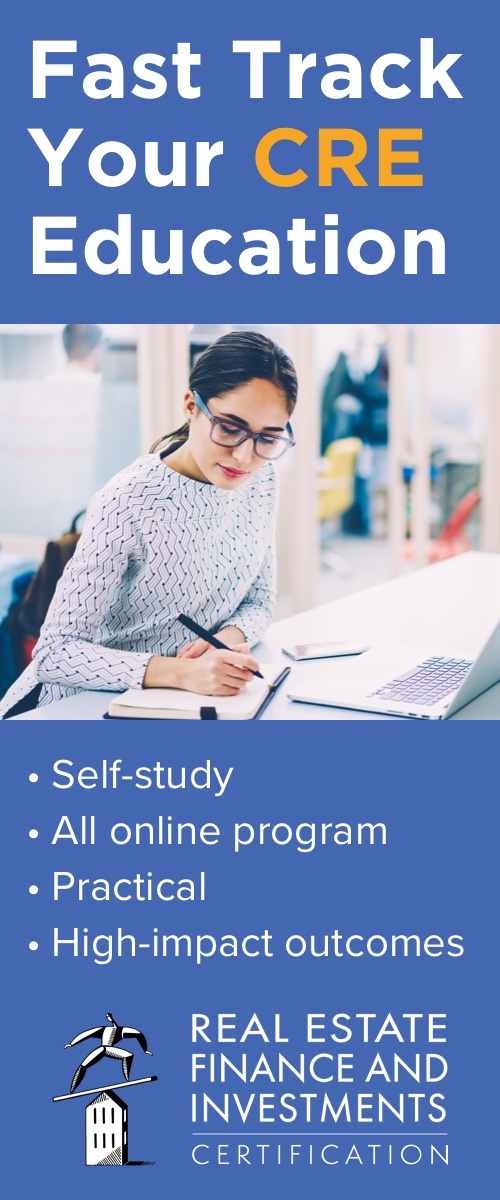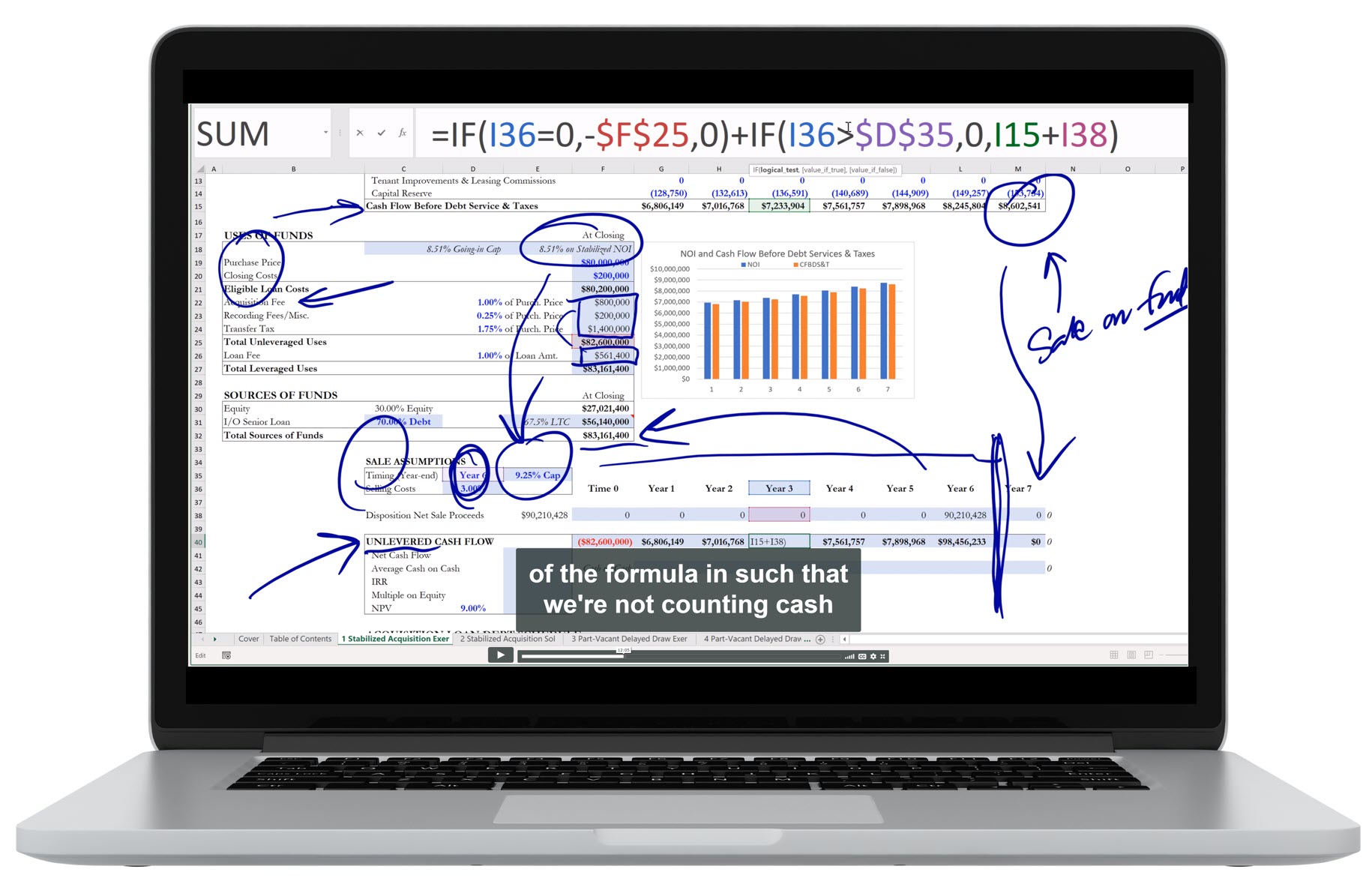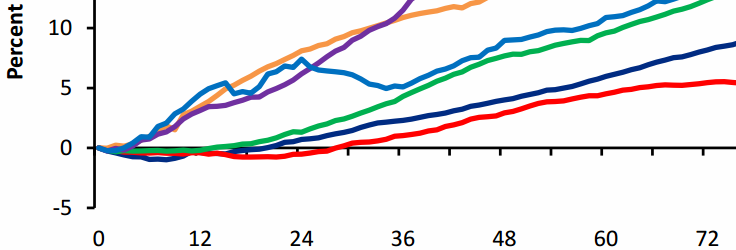Overview
Listen to this narration if you prefer
Chapter 14 focuses on why you might borrow. The chapter notes four reasons:
-
- You do not have sufficient cash to cover the full cost of purchasing or developing the asset.
- To diversify your investments (i.e., you do not want to commit a significant portion of your capital to just one investment).
- To enjoy the tax shield that interest provides.
- To enhance your equity returns.
While debt can be your friend in a rising market, you must remember that it substantially increases the investment risk for the equity holder. How much you should borrow depends on your needs, risk profile, and tax status.
Summary
U.S. commercial real estate mortgages are held overwhelmingly by banks (60%), followed by insurance companies, asset-backed securities issuers, and finance companies (a combined 28%), mortgage REITs (7%), and pension and retirement funds and others (6%).
Debt capital is inextricably linked to equity and property values. Senior debt is typically 60%-70% of the capital structure of a real estate transaction. There is a self-reinforcing mechanism between senior mortgage LTVs and property values, wherein LTVs rise along with property value and fall when property values fall.
Positive leverage means that the property cash flow yield (NOI after standard reserves) is greater than the interest rate paid to the lender. Negative leverage means that the property cash flow yield is less than the interest rate paid to the lender.
In Japan from 1997 to 2007, investors enjoyed positive leverage despite declining property values. Specifically, there was a big enough spread between financing costs and unlevered yields (i.e., large cash-on-cash returns) to enable investors to make money, even while their equity value was cut in half (property values declined by approximately 10%) during their hold period.
Mezzanine debt is any type of junior debt, whether holding the second, seventh, or other unsecured position. Mezzanine financing can also manifest as preferred equity, where you have specified rights above common equity but below senior debt. Additionally, mezzanine can be convertible debt where you hold debt but have the right to convert into common equity at specific terms. Mezzanine can also take the form of participating debt, where you receive an interest payment each year and also participate in any property income above a specified level. Simply put, mezzanine financing can be anything that is senior to the equity but junior to the most senior debt.
Questions
These are the types of questions you’ll be able to answer after studying the full chapter.
1. Why would someone choose to use debt?
2. What do positive and negative leverage mean?
3. How can someone earn a profit with debt financing when the value of their underlying asset is decreasing significantly?
4. What is mezzanine financing?
5. If you acquire a property for $10 million at an 8% cap rate and are able to finance 70% loan-to-value at 6% interest-only, what is your cash-on-cash return?
6. You just acquired a $200 million office building. What is your weighted average cost of debt financing if you take out a mortgage at 70% loan-to-value at 5.5% and a mezzanine loan at 10% that brings your loan-to-value up to 85%?
Audio Interviews
The two types of debt-related risk
BRUCE KIRSCH: One of the defining elements and the attractions of the real estate business is the possibility of using debt financing to acquire an asset. And this applies even if you don’t have a track record in the business. And as well, even if you don’t have other collateral that the lender could lien to secure this loan.
And so at the first time investor level this could be manifested in simply getting a mortgage for your first investment property, whether it’s a condo or a town home that you rent out.
And this ability to get debt financing– to access debt financing– with no track record and no other collateral is one of the main differentiators of real estate from other types of investment. Good luck trying to get a loan to– as a novice stock market investor– go invest in equity shares. It’s not going to happen. There’s just way too much risk involved.
And so the question becomes just because debt is available– just because you’re able to borrow to invest in real estate– should you in fact borrow and how much? And so in the textbook you make it clear that using debt financing is not without significant risks. So can you just tell us a little bit, what are the risks, and why do some students initially blind to these types of risks?
DR. PETER LINNEMAN: Well, to finish your thought, it’s not just students who are often blind to it. A lot of practitioners are blind. Let’s talk about what the risks are.
They really come in two varieties. One is that while you may think you’ve got more than enough income to pay the interest and principal that’s scheduled to be paid. When times get tough in the real estate market, often you find that your income is not sufficient to pay interest in principal that’s scheduled to be paid.
So you may start out with a fully leased building at peak rents, made at the peak of the cycle, and have a 1.2 interest coverage where you have 20% more than enough income to pay your scheduled interest payments. Well, then what happens is your income falls by 25%. Well, suddenly, you don’t have enough to cover your interest payments. And while that may be a temporary phenomena, that the market has fallen, your income’s off, it’s a very real phenomena.
So that what may look like a comfortable cushion– 20%, 30%, 40%, 50% even cushion to repay your interest and amortization may look like enough comfort, you get a tough market where tenants don’t renew. When tenants do renew its chewing up cash flow because you have to do tenant improvements. And on top of that, you have bad prospects for the future.
You can find that the real endangerment is when you took a loan you gave the first payment right to the lender. That is, first dollars that come in go to the lender not to you and your operations.
And that’s a real risk. It can impair operations. It can mean that since you don’t have enough money after paying the lender you don’t keep your building up. You defer capital expenditures. You defer hiring good leasing agents, et cetera.
So one of it is simply you just don’t have enough income. Your income gets a hit through the cycle or through competitive forces. And you don’t have enough money to service your income.
That never happens on a pro forma. In a pro forma everything always goes right. It’s only in reality that these things happen. And that’s one of the reasons this risk doesn’t look very high in that, gee, on my pro forma my income nicely goes up 2% a year or 3% a year. Rents are always rising. Space is always leasing. And therefore, I always have enough money to pay my interest in principal. It’s not always true.
Second variety of risk is what happens when the loan comes due. And short term debt comes due very quickly. In short term loans if you take out a one year loan it’s going to come due 10 times in a 10 year period. And even a 10 year loan eventually becomes a loan with one year maturity after nine years.
And the risk is that loan comes due at a bad time for the property. Namely, when your income is poor. When you’re leasing is poor. When tenants are uninterested in the space, et cetera.
Or that the property loan matures and comes due at a time that’s not so bad for the property but is terrible in terms of capital availability. So we talked about general growth for example, when we were talking about real estate companies.
Their problem was not that their properties were in such bad shape when their debt came due. Their problem was no one wanted to lend money to anyone when their loans came due. They all want their money back at that time.
And in fact, one of the things that happens to capital markets is that they run hot and cold. Sometimes people are willing to give money and lots of it to everyone, and other times they’re not willing to give any of it to anyone. They want it all back.
There have been a couple of times– the early ’90s for example. And again in the late 2000s– 2007, 2008, 2009, 2010– when your loan came due, especially if you had a good property, they wanted their money back. Because they knew they couldn’t get their money back by having borrowers whose properties were in trouble giving it to them.
So there’s two very distinct risks. One is an income stream risk– that you’ve given away the safe part of the income stream to the lender and therefore you may or may not have enough money to always pay your interest and principal.
And the second is you have to pay the loan off when it’s mature. And you cannot assume that there’ll be somebody willing to give you a big enough loan to repay your loan when it comes due. Because history has proven that’s not always the case. It generally is the case but not always.
And a lot of fortunes have been lost on the exceptions when it’s not available. Two very big risks. And I think real estate professionals forget that, because in normal times income’s OK to cover and people are willing to lend you money to repay your debt.
It’s the hard times. And the worst is when both are bad. When both the property’s income is bad and no one wants to lend at that time. That’s the worst of worst. Why do people ignore that? At their own peril, would be my only answer.
Good debt underwriting
BRUCE KIRSCH: So this speaks a lot to, again, what’s the nature of that particular cash flow stream in that particular property? How diversified is the tenant base, whether it’s a commercial property or a residential property?
You might be in Silicon Valley, and yes, you have an apartment building, but who are all the tenants? Well, all the tenants are people working for dot-coms. And then suddenly, when all of their employers evaporate, you’ve got a big, big problem.
PETER LINNEMAN: You are leasing to someone specifically. And there’s an old phrase, the guarantee is only as good as the guarantor. And when you sign a lease with someone, they’re effectively guaranteeing that they’ll make the scheduled lease payments.
But that guarantee is only as good as the guarantor. And if that’s not a good company, it’s not a solid company, they may be around to pay it. It’s not like all companies are credit quality. But they may not be. And that’s a risk, a serious risk.
It’s one of the reasons, for example, oftentimes in shopping centers, lenders will not treat as income income you receive as the landlord from certain tenants. They just don’t view them as strong enough credit quality. So you may have a million dollars in income from your tenants that may really be occurring, but the lender may only give you credit for $850,000 of that, saying that $150,000 is coming from sufficiently speculative credit tenants, that we’re going to underwrite it as if that income does not occur.
And that can be very frustrating because you say, well, the income’s really occurring. And they’re saying, yes, if it occurs, you win. We just don’t want to get it that if it doesn’t occur, for the reasons you’re suggesting, Bruce, that they’re stuck. And that’s part of what good debt underwriting involves.
BRUCE KIRSCH: And you mentioned how the debt markets, they run hot and they run cold. And I think it’s important for both students and professionals to really understand and appreciate that the pendulum does swing very far both ways. So in a hot.
PETER LINNEMAN: And fast. Not just far, but fast.
BRUCE KIRSCH: Right. Right.
PETER LINNEMAN: As you know, can go in a matter of months from an abundance of capital to a shortage of capital in that regard, from five people lining up to make the loan to you, to no one willing to make a loan to you at any amount of any nature. It can happen far faster, and that’s a risk.
Excel Figures
Key Terms
To view the definition, click or press on the term. Repeat to hide the definition.
The use of one or more layers of debt financing in a real estate transaction.
The mix of debt and equity that comprise a real estate transaction.
The combination of cash flow return and capital appreciation as it relates to equity invested.
The return you earn as the building’s value increases (or decreases).
The return earned from the cash flows generated by the property, net of any debt service.
The annualized compounded rate of return earned on an investment.
When the annual property cash flow yield % (NOI after normal reserves / Purchase Price) is higher than the annual interest rate paid to the lender.
When the annual property cash flow yield % (NOI after normal reserves / Purchase Price) is lower than the annual interest rate paid to the lender.
Annual cash flow after debt service divided by cumulative equity investment.
The expected average annual cash-on-cash yield plus the expected annualized capital appreciation.
Negative capital appreciation i.e., loss of property value.
All types of financing that are not secured by the real estate.
Debt holding the second, seventh, or another unsecured position.
Equity with specified rights above common equity, but below senior debt.
Debt that has the right to convert into common equity at specific terms.
Debt that receives an interest payment each year and also participates in any property income above a specified level.
A property’s blended cost of capital across all equity and debt components.
Chapter Headings
- Sources of Debt Capital
- The Four Reasons to Use Debt in a Transaction
- Do Not Have Enough Money
- Diversification
- Interest Tax Shield
- Enhanced Equity Returns
- Capital Appreciation
- Cash Flow Return
- Positive Leverage
- Negative Leverage
- Japan and Positive Leverage
- How Much Should You Borrow?
- Mezzanine Finance
Learn about REFAI Certification
< Ch 13 | Distressed Real Estate Loan and Bankruptcy Basics
Ch 15 | The Use of Debt and Mortgages >
Table of Contents
Index
Buy the Book







